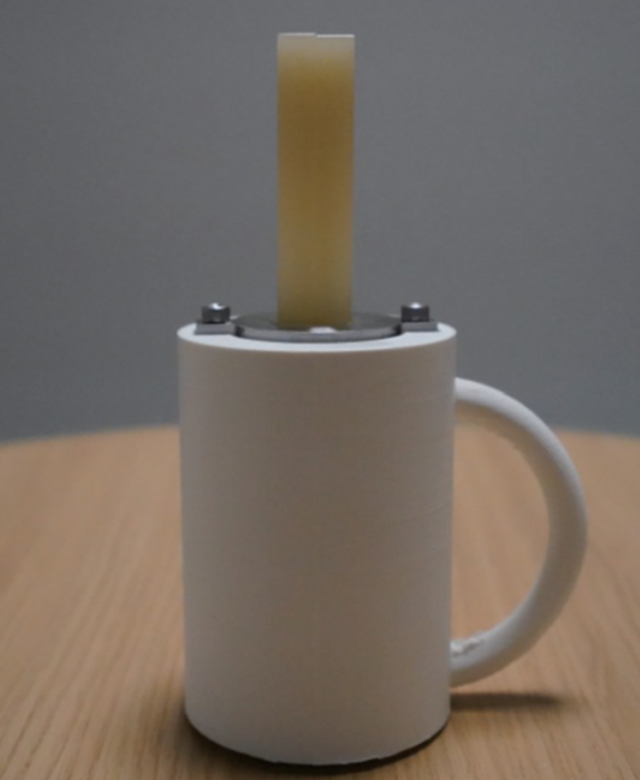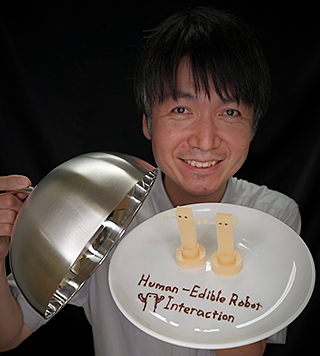Research HighlightsInnovation
October 2024 Issue
Food psychology Moving food sensation
Eating is essential for humans to stay alive. In addition, the consumption of food has social and cultural connotations. The eating of live fish or other seafood, for example, is a custom that exists in Japan, where it is referred to as “odorigui”, literally meaning “dancing eating”. Live food consumption is an interesting field of study from a psychological point of view — indeed, people may experience different moral emotions when consuming live creatures. Performing controlled psychology experiments with people eating live food is challenging, however. Synthetic moving food offers an alternative means for studying such eating experiences. Now, Yoshihiro Nakata from The University of Electro-Communications, Tokyo, and colleagues have developed a moving, edible robot based on gelatin and sugar [1]. Introducing the concept of human–edible robot interaction, they demonstrated that the robot enables controlled experiments probing the human psychology of animated food consumption.
The robot consisted of a stick-shaped edible part plugged into a socket containing ‘hardware’ controlling the motion. Specifically, the socket functions solely as a connector, with all other pneumatic devices located outside of it. A pneumatic design was used, because of both its drivability and its harmlessness (air can be ingested); changes in air pressure cause the edible stick to deform. For the edible material, Nakata and colleagues used a mixture of gelatin, apple juice, sugar and calcium carbonate. Various experiments were carried out to arrive at the optimal component ratios, resulting in a stick, reminiscent of gummy candy, with the right tensile strength and hardness.
In a first experiment, the scientists asked people to watch videos of the robots showing two types of motion: lateral, swinging movements, and up-and-down movements. They also varied the speed of these movements. These different modes could be generated and controlled by changing the air supply and exhaust in the robot’s pneumatic chambers. Participants were then asked questions regarding their impressions and emotions upon seeing the moving robot.
The main outcome was that lateral motion was perceived as corresponding to a higher degree of emotion, animateness, and intelligence, with medium speed generating the more positive impression. Furthermore, Nakata and his colleagues have performed an exploratory factor analysis, which revealed two distinct factors as being perception and taste as shown in Table 5 of reference 1. In terms of speed, a difference was found between "Short and Middle" compared to "Long” and in the second experiment described below, the researchers used the "Middle" setting, but to be clear, this does not imply that only the "Middle" speed showed a significant difference in the first experiment.
In a second experiment, participants were asked to actually eat the edible robot. They first needed to hold the edible part in their mouth for 10 seconds, to make sure they experienced the sensation of the robot’s motion. After that, they had to bite the edible part off, chew on it, and swallow it. Again, the participants were asked questions, this time assessing the eating experience, including the issue of feeling guilty or not about what they just ate. A comparison experiment was done with the edible robots in non-moving mode. Moving and non-moving modes affected participants perception of the robot’s texture, described by the onomatopoeia “kori-kori” (crisp) and “gabu” (grappling) for moving and “munya-munya” (mumble) for non-moving situations. As a potential interpretation of their findings, Nakata and colleagues suggested that participants may attribute lifelike qualities to the robot, such as animateness, emotion and intelligence, which intensifies the eater’s perception. The link in Reference 3 connects to a video demonstrating the “Human-Edible Robot Interaction” described in this research.
Although the reported study has some limitations — the developed robots do not yet mimic living creatures, and they need to remain connected to their base for functionality, for example — it establishes human–edible robot interactions as a research direction, opening up many possibilities for future research. Quoting the scientists: “We believe that providing users with the experience of “eating a robot” […] may highlight subconscious human attitudes […] toward living organisms and robots.”

[Fig. 5b from the paper]
Pneumatically driven movable robot, with edible part (top) and non-edible base (bottom).
References


1. 1. Yoshihiro Nakata, Midori Ban, Ren Yamaki, Kazuya Horibe, Hideyuki Takahashi, Hiroshi Ishiguro, Exploring the eating experience of a pneumatically-driven edible robot: Perception, taste, and texture, PLoS ONE 19(2), e0296697.
URL:
https://journals.plos.org/plosone/article?id=10.1371/journal.pone.0296697
DOI:
10.1371/journal.pone.0296697
2. Table 5 in the paper of reference 2: https://doi.org/10.1371/journal.pone.0296697.t005
3. Demonstration video : Human-Edible Robot Interaction
https://youtu.be/OoAszrv5vy4
Nakata Lab website
http://www.nakata-lab.mi.uec.ac.jp/home/


